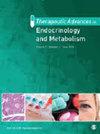MAFLD 中的肠道微生物群:治疗和诊断意义
IF 4.6
3区 医学
Q2 ENDOCRINOLOGY & METABOLISM
Therapeutic Advances in Endocrinology and Metabolism
Pub Date : 2024-04-15
DOI:10.1177/20420188241242937
引用次数: 0
摘要
代谢功能障碍相关性脂肪肝(MAFLD),以前被称为非酒精性脂肪肝,正在成为全球慢性肝病的重要致病因素,其发病率已超过病毒性肝炎等其他病因。目前迫切需要预防和早期治疗策略来遏制其日益增长的发病率。最近的证据表明,针对肠道微生物群可能有助于治疗和缓解 MAFLD 患者的疾病进展。本综述旨在探讨 MAFLD 与肠道微生物群之间在疾病发病机制方面的复杂关系。此外,它还深入探讨了针对肠道微生物群的治疗策略,如饮食、运动、抗生素、益生菌、合成益生菌、胰高血糖素样肽-1受体激动剂和粪便微生物群移植,并讨论了新型生物标记物,如微生物群衍生检测和液体活检,以了解其诊断和分期的潜力。总之,这篇综述强调了对预防和治疗策略的迫切需要,以解决 MAFLD 在个人和社会层面造成的破坏性后果,并认识到进一步探索肠道微生物群可能会为将来有效管理 MAFLD 开辟道路。本文章由计算机程序翻译,如有差异,请以英文原文为准。
Gut microbiota in MAFLD: therapeutic and diagnostic implications
Metabolic dysfunction-associated fatty liver disease (MAFLD), formerly known as nonalcoholic fatty liver disease, is becoming a significant contributor to chronic liver disease globally, surpassing other etiologies, such as viral hepatitis. Prevention and early treatment strategies to curb its growing prevalence are urgently required. Recent evidence suggests that targeting the gut microbiota may help treat and alleviate disease progression in patients with MAFLD. This review aims to explore the complex relationship between MAFLD and the gut microbiota in relation to disease pathogenesis. Additionally, it delves into the therapeutic strategies targeting the gut microbiota, such as diet, exercise, antibiotics, probiotics, synbiotics, glucagon-like peptide-1 receptor agonists, and fecal microbiota transplantation, and discusses novel biomarkers, such as microbiota-derived testing and liquid biopsy, for their diagnostic and staging potential. Overall, the review emphasizes the urgent need for preventive and therapeutic strategies to address the devastating consequences of MAFLD at both individual and societal levels and recognizes that further exploration of the gut microbiota may open avenues for managing MAFLD effectively in the future.
求助全文
通过发布文献求助,成功后即可免费获取论文全文。
去求助
来源期刊

Therapeutic Advances in Endocrinology and Metabolism
Medicine-Endocrinology, Diabetes and Metabolism
CiteScore
7.70
自引率
2.60%
发文量
42
审稿时长
8 weeks
期刊介绍:
Therapeutic Advances in Endocrinology and Metabolism delivers the highest quality peer-reviewed articles, reviews, and scholarly comment on pioneering efforts and innovative studies across all areas of endocrinology and metabolism.
 求助内容:
求助内容: 应助结果提醒方式:
应助结果提醒方式:


